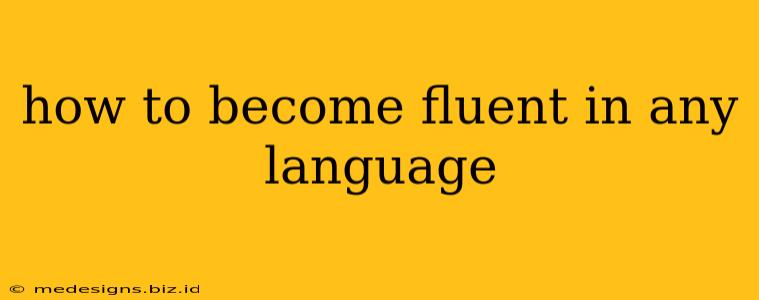Learning a new language is a rewarding journey, opening doors to new cultures, experiences, and opportunities. But achieving fluency takes dedication and a strategic approach. This comprehensive guide outlines effective methods to help you become fluent in any language you choose.
Understanding the Path to Fluency
Fluency isn't just about memorizing vocabulary; it's about mastering the four key language skills: reading, writing, listening, and speaking. It's also about understanding the nuances of the language, including cultural context and idiomatic expressions. There's no magic bullet, but consistent effort and the right strategies are key.
Setting Realistic Goals & Expectations
Before you begin, set SMART goals: Specific, Measurable, Achievable, Relevant, and Time-bound. Instead of aiming for "fluency," set smaller, achievable goals like "learn 50 new words per week" or "have a 15-minute conversation with a native speaker by the end of the month." This helps you track progress and stay motivated.
Effective Learning Strategies
Here are some proven strategies to accelerate your language learning journey:
1. Immerse Yourself in the Language
Immersion is arguably the most effective method. Surround yourself with the language as much as possible:
- Listen to music and podcasts: This helps you get accustomed to the rhythm and intonation of the language.
- Watch movies and TV shows: Start with subtitles, then gradually try watching without them.
- Read books and articles: Choose materials that interest you to maintain engagement.
- Change your phone and social media settings: This constant exposure reinforces learning.
2. Active Learning Techniques
Passive learning (like simply listening) is not enough. Engage actively with the language:
- Use flashcards: Flashcards are a great way to memorize vocabulary and grammar rules. Apps like Anki can make this process even more efficient.
- Practice speaking: Find language exchange partners, tutors, or conversation groups. Don't be afraid to make mistakes—it's part of the learning process!
- Write regularly: Keep a journal, write short stories, or even just practice writing sentences.
- Utilize language learning apps: Duolingo, Babbel, and Memrise offer gamified learning experiences that can make studying more enjoyable.
3. Focus on all Four Skills
Don't neglect any of the four key skills:
- Reading: Improves vocabulary and grammar understanding.
- Writing: Reinforces grammar and vocabulary, and allows for self-expression.
- Listening: Develops comprehension and pronunciation.
- Speaking: The most important skill for fluency, requiring consistent practice.
4. Embrace Mistakes and Seek Feedback
Mistakes are inevitable, and they are crucial for learning. Don't be afraid to make them! Actively seek feedback from native speakers or tutors to identify areas for improvement.
Maintaining Motivation & Consistency
Learning a language takes time and dedication. Maintaining motivation is key:
- Find a language partner: Learning with a friend or partner can increase motivation and provide accountability.
- Set realistic goals: Avoid overwhelming yourself with overly ambitious targets.
- Celebrate your progress: Acknowledge your achievements along the way to stay motivated.
- Make it fun: Find ways to make learning enjoyable, such as watching movies, listening to music, or joining a language exchange group.
Conclusion: Your Journey to Fluency
Becoming fluent in any language requires dedication, the right strategies, and a positive attitude. By combining immersion, active learning techniques, focusing on all four language skills, and maintaining motivation, you can achieve your language learning goals and unlock a world of opportunities. Remember, consistency is key – even small daily efforts will accumulate over time to bring you closer to fluency. Embrace the challenge, enjoy the process, and celebrate your success along the way!
